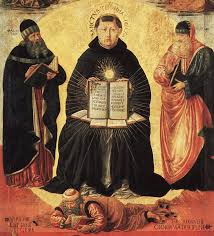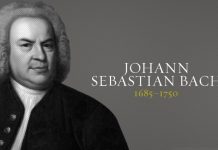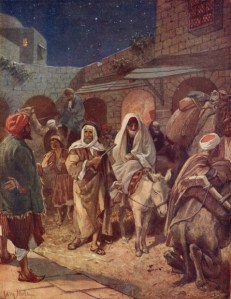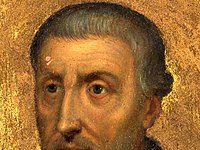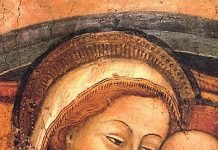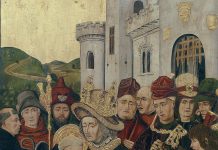St. Thomas Aquinas (1225-1274), famously known to Catholics as the Angelic Doctor, was born in Italy to prosperous parents of royal lineage. At the age of five he impressed everyone by continually asking, “Quid est Deus?” (What is God?) Recognizing the precocious intellect of their son, his parents sent him to the best Benedictine teachers for instruction. It was the dream of his mother that he might be Archbishop of Naples or even Abbot of Monte Casino. By his eighteenth year he transferred to a Dominican monastery for more advanced learning and began his life-long search for the answer to the burning question of his youth.
Aquinas Becomes a Dominican
Eventually Aquinas was convinced he did not want to return to the Benedictines and asked his Dominican superiors if he could wear the cloth of St. Dominic. They granted his request. His parents were enraged by their son’s decision, since the Dominicans were famous not only as scholars, but also as an order of beggars.
Finally, a plan was hatched by his mother and his brothers to kidnap him and hold him hostage at the family castle until he would come to his senses. This done, Thomas obstinately refused to change his mind about becoming a Dominican. For two years he was kept imprisoned in his room. Desperate, his brothers then arranged for a woman of loose reputation to be sent to his chamber to seduce him and change his mind about becoming a priest. That night a loud scream was heard in the castle, and when the brothers rushed to Thomas’ bedroom they found him brandishing a burning ember from the fireplace that he had used to drive the woman from his bedroom.
Thomas’ sisters later devised a plan to help him escape by lowering him from his chamber window, whereupon he fled to Rome and begged Pope Innocent to order his return to the Dominican Order. His parents were summoned by the pope to make their case, and after hearing both sides, the pope sided with Thomas, realizing that his plea was earnest and that his promise as a scholar of considerable genius would bring great honor to the Church. Understanding their cause was futile, the parents relented and Thomas was sent to Paris for further studies. There he was made a student of the great Dominican professor, Albertus Magnus. So it was that Thomas embarked on his career as philosopher, theologian, and defender of the faith.
One day Thomas was called from his cell by another student who yelled, “Thomas, quick, come here and look at the flying ox.” Thomas went to the window and no sooner made his appearance than he was shouted at and jeered by a crowd of students who were amused by his eagerness to see what the commotion was all about. One student asked Thomas how he could be so gullible as to believe that an ox could fly. To which Thomas gently replied, “I did not believe that an ox could fly, nor did I, until now, believe that a young religious could tell a falsehood.”
On another occasion he was asked by a fellow student to solve a complex philosophical problem. On his way to class, the parchment on which Thomas had written his views fell to the floor, was found by a fellow student, and was taken to Professor Albertus, his teacher, who read the paper and promptly announced to his assembled class: “You call him a Dumb Ox, but I tell you one day he will astound the world with his bellowing!”
Thomas was educated in the European university system first created and sustained under the auspices of the Catholic Church. University scholarship had finally brought Europe out of the Dark Ages. The thirteenth century was really the seminal time for the scientific breakthroughs of later centuries. Those who think that modern science just sprang forth magically from the brow of Copernicus, Galileo, and Newton, little realize how much the development of modern rational thought is indebted to the centuries-long struggle of the Catholic Church to nurture and promote discoveries about Nature as the plan of God’s mind in the universe.
Aquinas as Scholar
For the next few years Thomas taught, debated, wrote, and was much in demand by popes and bishops as a theologian who had surpassed all his contemporaries in depth of thought and power of expression. In 1265, ten years before his death, he was appointed by Pope Clement IV as Archbishop of Naples, but wisely refused the honour. This was fortunate for the Church; had he accepted, in all likelihood he would never have written his monumental Summa Theologica. So universally admired was this masterpiece that when the printing press was invented by Gutenberg, the Summa was chosen as one of the first major works after the Bible to be printed on it.
The Summa is a virtual miracle of intellectual gymnastics. Thomas, with his encyclopedic memory and penetrating intellect, drew upon sources ancient and current to fathom the depths of every imaginable theological question. He employed the clever format of introducing his topic, followed by an array of arguments on one side, in turn followed by answers to those arguments on the other side, and also the statement of his own conclusion. “Fair and balanced” might be said to be his constant modus operandi.
As to his style of writing, it has been called majestically simple, clear, and inimitable. Here are three examples:
“To one who has faith, no explanation is necessary. To one without faith, no explanation is possible.”
“The things that we love tell us what we are.”
“Man cannot live without joy; therefore when he is deprived of true spiritual joys it is necessary that he become addicted to carnal pleasures.”
“Three things are necessary for the salvation of man: to know what he ought to believe; to know what he ought to desire; to know what he ought to do.”
Aquinas by hard work and gifts of the Holy Spirit learned to join art with truth in such a way as to let truth shine forth. A sometimes abstract philosopher (too abstract for some readers) he was grounded in common-sense reality. As Chesterton said, he was not like the “mystic who shrinks from the world and lives only in his mind.” Chesterton also offered the ultimate compliment to St. Thomas when he said that “in reading Aquinas’s philosophy, I have a very peculiar and powerful impression analogous to poetry.”
On Proving God Exists
Wars sometimes have unexpected consequences, and the Crusades were certainly no exception. The Crusaders returned to Europe loaded down with captured manuscripts of writings from the ancient world. The ones that were of most interest to Aquinas were those of Aristotle. Augustine had done much to bring Plato into Catholic theology. Now Aquinas would do the same for Aristotle, baptizing (purifying) him, as it were, by enlisting his philosophy in the service of a rational approach to the existence of God and the truths of Christian morality. Of special note, as presented in the Summa Theologica, are the famous five proofs for the existence of God.
We can see Thomas, for example, lifting directly out of Aristotle the First Cause argument to prove the existence of God. While in some respects Aristotle’s argument may not convince an atheist, its fundamental thrust, which is that there must be a First Cause, has been somewhat vindicated in the discovery of modern astronomy that the universe once did not exist, and then came to exist at the time of an event called the Big Bang. The question is inevitable: What or Who caused the Big Bang? Unfortunately, scientists today, unlike scientists such as Copernicus, Galileo, and Newton, cannot fathom why the First Cause should be a Who rather than a What.
Aquinas, following Aristotle, also developed his “fifth proof” for the existence of God from the observation of design in the universe. This is called the teleological proof, which only came to be seriously challenged as a result of Darwinian biology. Ironically, it has resurfaced somewhat modified in the modern Intelligent Design movement advocated by some modern biologists. James D. Watson, one of the scientists who discovered the chemical structure of DNA, despaired of believing that life could have originated by pure accident and turned to a hypothesis of aliens who must have planted the first germs of life on earth. But all Watson did was push the question farther back. Who designed the aliens?
Thomistic Political Philosophy
In his Summa Theologica Aquinas can be found developing views on the nature of government that might well have been studied by Jefferson, Madison, Hamilton and others. He says:
“One of the principal things to be considered with regard to the good establishment of princes [rulers] is that all should have some part in the government; for in this way peace is preserved among the people, and all are pleased with such a disposition of things and maintain it. The next thing to be considered is the form of government, of which there are principally two kinds: a Kingdom, in which one rules, and an Aristocracy, in which a few exercise the authority. The best form is that in which one rules over all, and under him there are others having authority, but the government pertains to all, because those who exercise authority can be chosen from all and are chosen by all. . . . Hence the best government is a mixture of a Kingdom, of Aristocracy, and of Democracy, i.e., of the power of the people, inasmuch as the rulers can be chosen from the people, and the election of the rulers belongs to the people.”
One could say that Aquinas anticipated modern thought if we substitute a President for a King, a Supreme Court for an Aristocracy, and a Congress elected by the people for a Democracy.
On the Immaculate Conception
Long before the doctrine of the Immaculate Conception was defined by the Church, Aquinas weighed in on the controversy that had been ongoing since before the days of Augustine. As with Augustine, and also with Bernard of Clairvaux, Aquinas found the notion difficult to fathom. If Mary was conceived without sin, how was she to be redeemed by Christ? He found a compromise by suggesting that Mary did inherit the stain of original sin, but that she was cleansed of that sin by the Lord while in the womb. Thus, when the angel Gabriel addresses her as “full of grace,” that is true; there is literally no stain of original or personal sin in her.
The Death Penalty
Aquinas visited and revisited this matter several times in his writings, suggesting that it deeply mattered to him whether he had acquired the right view. In the end, we know that, like Augustine before him, the penalty for Aquinas seemed to be a just reply to serious criminal conduct. Keeping in mind that the salvation of the soul was more important than the salvation of the body, Aquinas said in his Summa Theologica: “If a man be dangerous and infectious to the community, on account of some sin, it is praiseworthy and healthful that he be killed in order to safeguard the common good, since “a little leaven corrupteth the whole lump” (1 Cor. 5:6).”
And again: “They (the condemned) also have at that critical point of death the opportunity to be converted to God through repentance. And if they are so obstinate that even at the point of death their heart does not draw back from malice, it is possible to make a quite possible judgment that they would never come away from evil.”
On Hell
Aquinas appears to regard hell as a place of torment not only for what we did or failed to do, but also for what we knew or willfully failed to know. As he says:
“In the damned there will be actual consideration of the things they knew heretofore as matters of sorrow, but not as a cause of pleasure. For they will consider both the evil they have done, and for which they were damned, and the delightful goods they have lost, and on both counts they will suffer torments. Likewise they will be tormented with the thought that the knowledge they had of speculative matters was imperfect, and that they missed its highest degree of perfection which they might have acquired“.
As to the eternity of hell, Aquinas concurs with Augustine that men, along with the devils, cannot escape the fires.
The magnitude of the punishment matches the magnitude of the sin. Now a sin that is against God is infinite; the higher the person against whom it is committed, the graver the sin—it is more criminal to strike a head of state than a private citizen—and God is of infinite greatness. Therefore an infinite punishment is deserved for a sin committed against Him.
On War
Following Augustine, Aquinas asserted the theory that a just war must be limited to three conditions: (1) that it be lawfully declared; (2) that it be for a just cause to settle wrongful actions; (3) that it be conducted with rightful intent to do good and avoid evil. Aquinas did not believe that war should be avoided at all cost, since to do so would be to abandon justice; but violence should always be the last resort to establish a just peace, and cruelty (war crimes) should never prevail.
Had he lived in modern times, Aquinas would likely have seen a war to resist the aggression of Nazi Germany as a just war, since there could be no peace by submitting to the hateful tyranny of Hitler. He might well have seen the war with Japan as a just war, responding to the unjust invasion of the Hawaiian Islands, the Phillippine Islands, and other selected targets of conquest; but he might have condemned the dropping of nuclear weapons on Japan (liquidating thousands of civilians) as an intentionally cruel act, rooted more so in vengeance for Pearl Harbor, or for mitigating the death of American troops invading Japan, than in the desire for a just peace. There is abundant evidence, as I think Professor John Paul Meenan has recently noted, that concluding hostilities with Japan needn’t have required a full scale invasion resulting in a colossal death count for American soldiers
Aquinas on the Eucharist
One of the spectacular effects of Aristotle on Aquinas was the use Aquinas made of Aristotle’s metaphysics to explore the nature of Transubstantiation that occurs to the bread and the wine during Mass. Ever since the time of the Last Supper, Catholics have taken the bread and wine, blessed it, and shared it as the actual Body and Blood of Jesus Christ. Justin Martyr, about the year 164 A.D., in these words documents the celebration of the Eucharist:
“And this food is called among us Eucharistia [the Eucharist], of which no one is allowed to partake but the man who believes that the things which we teach are true, and who has been washed with the washing that is for the remission of sins, and unto regeneration, and who is so living as Christ has enjoined. For not as common bread and common drink do we receive these; but in like manner as Jesus Christ our Savior, having been made flesh by the Word of God, had both flesh and blood for our salvation, so likewise have we been taught that the food which is blessed by the prayer of His word, and from which our blood and flesh by transmutation are nourished, is the flesh and blood of that Jesus who was made flesh.” (First Apology)
By the 11th century it appears that theologians were starting to break away from this belief. Berengarius of Tours, for example, believed that the presence of Christ in the wine and bread was purely spiritual, not physical. After being challenged on numerous occasions, condemned as a heretic, and frequently being obliged to retract his views, Berengarius resolved to submit to orthodoxy and died in the embrace of the Church.
Hildebert of Lavardin, a contemporary of Berengarius, first introduced the term “transubstantiation” in his refutation of Berengarius. Unfortunately, the views of Berengarius survived his lifetime and began to spread through Europe until the arrival of Thomas Aquinas. At one point the Feast of Corpus Christi was initiated as a reminder to the universal Church that the institution of the Eucharist had indeed survived the assault.
Aquinas decided to answer all doubts about the Real Presence by explaining how Christ could be truly, not just figuratively, present in the bread and wine. He turned to the ancient pagan philosopher Aristotle for help. In Aristotle’s metaphysics the distinction is made between a substance and its accidents. I am a human being. That is my substance. My accidents are, among others, that I am elderly, educated, nearly bald, 5’7” tall and fair-skinned. Now, normally when one substance converts into another, its accidents go away, as my present accidents will go away when my substance returns to the dust from whence I came. This would be a transformation of my substance into dust. Dust is simple, so the accidents of my dust will be simple too. But when by the miracle of transubstantiation the bread and wine turn into the Body and Blood of Jesus, the substance and accidents of bread and wine cannot become the substance and accidents of Jesus, who is already present Body and Spirit, and so they remain visible illusions to us as substance and accidents of both bread and wine. As Dennis Beach has put it: “Transubstantiation maintains instead that being or substance changes while appearance [accidents] remains the same.”
Aquinas concludes:
“Some might object that none of this is believable. But it is evident to sense that all the accidents of the bread and wine remain after the consecration. And this is reasonably done by Divine Providence, first of all, because it is not customary, but horrible, for men to eat human flesh, and to drink blood. And therefore Christ’s flesh and blood are set before us to be partaken of under the species of those things which are more commonly used by men, namely, bread and wine”.
This is just as believable as the Incarnation, the belief that God the Son, by a miracle we cannot understand, “transubstantiated” himself, entered into the human race, in the Person (substance and accidents) of Jesus Christ. If we can believe that, we can as well believe, by a miracle we cannot understand, that the Son of God enters bread and wine which become his Body and Blood. Because Christ’s divine Body in the Eucharist is not bound by the substance and accidents of time and space, or by the substance and accidents of bread and wine, God can also be present to us in all places and at all times, as he promised us (Matthew 28:20); and that is assured by the priest’s daily sacrificial act at the altar.
Aquinas as Poet
Like Augustine before him, Aquinas had his great poems of adoration. For the Feast of Corpus Christi we have from his pen that glorious hymn to the Eucharist that is sung in Latin or English at Benediction services throughout the world. Aquinas wrote the hymn given here, at the request of Pope Urban IV for the occasion of extending the Feast of Corpus Christi to the entire world.
Pange Lingua Gloriosi
(traditional translation)
Sing, my tongue, the Savior’s glory,
of His flesh the mystery sing;
of the Blood, all price exceeding,
shed by our immortal King,
destined for the world’s redemption,
from a noble womb to spring.
Of a pure and spotless Virgin
born for us on earth below.
He, as Man, with man conversing,
stayed, the seeds of truth to sow;
then He closed in solemn order
wondrously His life of woe.
On the night of that Last Supper,
seated with His chosen band,
He the Pascal victim eating,
first fulfills the Law’s command;
then as Food to His Apostles
gives Himself with His own hand.
Word-made-Flesh, the bread of nature
by His word to Flesh He turns;
wine into His Blood He changes;
what though sense no change discerns?
Only be the heart in earnest,
faith her lesson quickly learns.
Down in adoration falling,
Lo! the sacred Host we hail;
Lo! o’er ancient forms departing,
newer rites of grace prevail;
faith for all defects supplying,
where the feeble senses fail.
To the everlasting Father,
and the Son who reigns on high,
with the Holy Ghost proceeding
forth from Each eternally,
be salvation, honor, blessing,
might and endless majesty.
Amen.
Death and Sainthood
Aquinas near the age of fifty was on his way to Rome to advise yet another pope when he fell deathly ill and was taken in at a nearby Cistercian monastery. After receiving the Last Rites, he uttered the following act of faith:
“Thee have I preached; Thee have I taught. Never have I said anything against Thee. If anything was not well said, that is to be attributed to my ignorance. Neither do I wish to be obstinate in my opinions, but if I have written anything erroneous … I submit all to the judgment and correction of the Holy Roman Church, in whose obedience I now pass from this life“.
Would that all theologians could be so humble.
About fifty years after his death, Pope John XXII pronounced Thomas a saint. In the course of examining his cause for sainthood, at least 300 miraculous interventions were attributed to him. Two centuries later, in 1567, Pope Pius V proclaimed Thomas a Doctor of the Church and ranked his feast with those of Ambrose, Jerome, and Gregory.
At the Council of Trent, which was called to address the Protestant Reformation, two books were placed on the altar at Mass each day: The Bible and Thomas’ Summa. Also at this Council the doctrine of Transubstantiation was defined, with Thomas’s explanations used to combat the growing heresies of the Lutherans, the Calvinists, and others who favored the opposing doctrine of Consubstantiation, which denies the Real Presence in the bread and wine.
Because of all the theological disputes that have divided Christendom against itself, the world has suffered greatly. We do not live rightly by agonizing through endlessly militant theological squabbles over this and that. One can imagine Saint Thomas resurrected by special proclamation of heaven to attend the Council of Trent that ended so tragically in that it failed to stem the steady disintegration of Christendom. And one can imagine him surrounded by cardinals and bishops as he steps forward in the great assembly at Trent to utter first, with majestic simplicity, words he had uttered once before: “How can we live in harmony? First we need to know we are all madly in love with the same God.”

